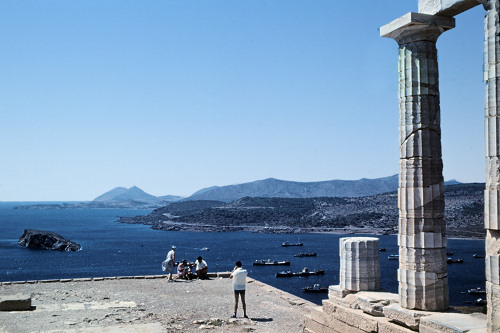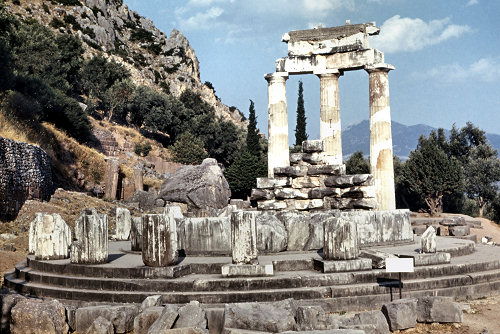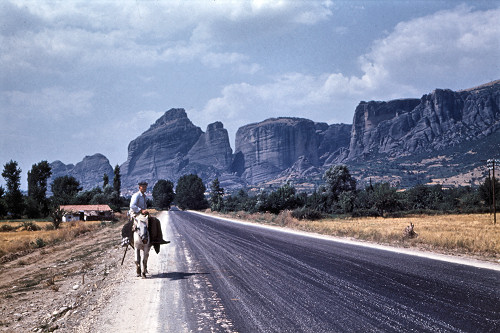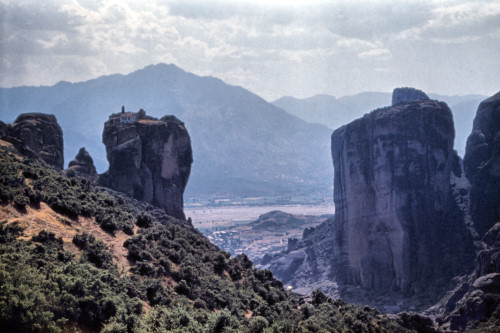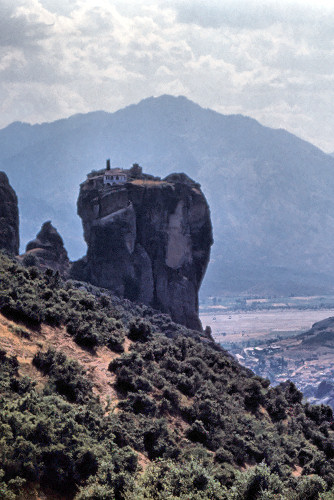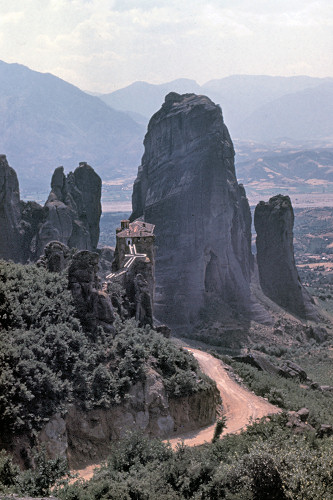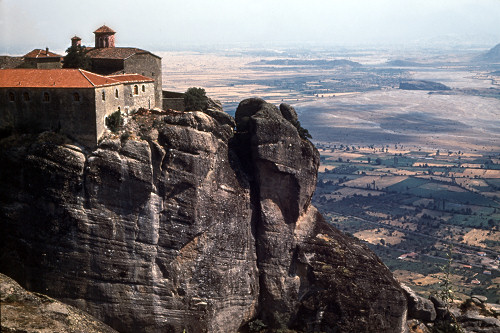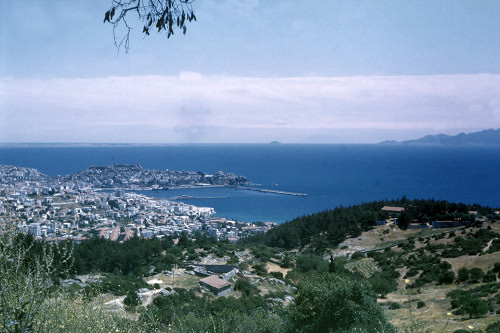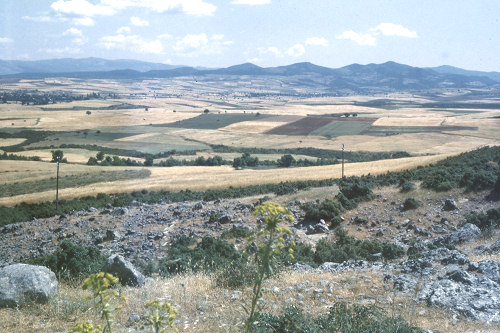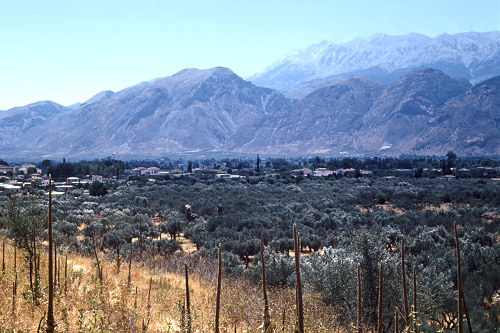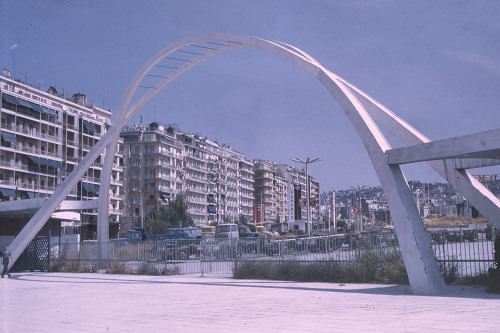| *From: http://www.sacredsites.com/1st30/tholos.html
One hundred miles northwest of Athens,
soaring high above the Gulf of Corinth, stands the holy mountain
called Parnassus. Nestled amidst the pine forested slopes and rocky
crags of the sacred peak are the beautiful and exceptionally
well-preserved ruins of Delphi. A city of wondrous artistic
achievements and grand athletic spectacles during the flowering of
Greek culture in the first millennium BC, Delphi is best know however
as the supreme oracle site of the ancient Mediterranean world.
According to the earliest legends the site was originally a sacred
place of the earth goddess Gaia (also called Ge) and was guarded by
her daughter, the serpent Python. Later legends state that the site
was the center of the world as determined by the god Zeus. Two eagles
had been released by Zeus from opposite ends of the earth and
following great flights across the skies they finally met at Delphi. A
still later legend relates that Apollo, the son of Zeus, came from his
home atop Mt. Olympus to Mt. Parnassus to slay the great serpent
Python. Fleeing from the peak Python sought safety in the sanctuary of
the Earth Mother at Delphi. Apollo relentlessly pursued Python,
however, and violently claimed the site. Later repenting of his crime,
Apollo purified himself and, returning to Delphi, persuaded Pan (the
goat-god of wild places and evocative music) to reveal to him the art
of prophecy. Upon the site of his battle, Apollo erected his own
oracular temple and, at the exact place where he had 'speared' the
serpent, an omphalos stone was set in the ground.
This omphalos stone (meaning 'center of the earth' to the
ancient Greeks) later became the center of the inner sanctum of the
shrine of the Delphic oracle. The site was originally called Pytho,
after the guardian serpent. It was renamed Delphi after the dolphin (delphis
in Greek) whose form Apollo took in order to bring Cretan sailors to
Delphi so that they might become priests in his new temple. Regarding
the omphalos, one legend tells that the original stone, now lost, was
a large meteorite fallen from the sky in deepest antiquity. The
omphalos stone currently on display in the Delphi museum, while very
old and indeed from Delphi, is thus not the original sacred stone. It
is interesting to inspect this exhibited stone however, for its
conical form and sculptural designs derive from the old pillar and
tree worship of the prehistoric goddess cults.
Archaeologically (as contrasted to the mythological discussion above)
we know but little about the early beginnings of Delphi. Excavations
have revealed the site was a Mycenean village from 1500 to 1100 BC,
during which time the primary religious emphasis was on an oracular
cult of the Earth Goddess. Around 1000 BC the worship of Apollo became
dominant when this new god was brought to the region by either Dorians
from Crete or northern tribes from Thessaly. The oracular use of the
site continued during Apollo's occupation and, through the endeavors
of politically astute priests, Delphi achieved Panhellenic fame as a
major oracle shrine by the 7th century BC.
Women, who were considered more sensitive than men to the oracular
powers of the site, would first bathe in the waters of the nearby
sacred Castalian spring (said to have been created when the
winged-horse Pegasus struck the ground with his hoof, and to be
haunted by the three Muses). Next they would drink from the sacred
Kassotis spring and then, sitting in meditation near the omphalos
stone, would enter into a visionary trance state. Many archaic
accounts of Delphi relate that the oracular priestesses, known as
Pythia, sat upon a chair situated over a fissure in the earth from
which emanated trance-inducing vapors. Plutarch, a Greek philosopher
who served as a priest at Delphi, and Strabo, an ancient geographer
had each told of geologic fumes that inspired divine frenzies, with
Plutarch noting that the gases had a sweet smell.
Until recently this matter was considered to be a fabrication from
post-Delphic times. French archaeologists began excavating the ruins
in 1892, digging down to the temple's foundations, but no evidence of
a fissure or fumes was found. By 1904, a visiting English scholar, A.
P. Oppé, declared that ancient beliefs in temple fumes were the
result of myth, mistake or fraud. The Oxford Classical Dictionary in
1948 voiced the prevailing view: "Excavation has rendered
improbable the postclassical theory of a chasm with mephitic vapours."
During the late 1990’s however, a geologist, an archaeologist, a
chemist and a toxicologist teamed up to produce a wealth of evidence
suggesting that the ancient legends had in fact been accurate. The
region's underlying rocks turn out to be composed of oily limestone
fractured by two hidden faults that cross exactly under the ruined
temple, creating a path by which petrochemical fumes (methane, ethane
and ethylene) could rise to the surface to help induce visions. In
particular, the scientists found that the women communing with the
oracle probably came under the influence of ethylene - a
sweet-smelling but psychoactively potent gas once used as an
anesthetic. In light doses, ethylene produces feelings of disembodied
euphoria and visionary insight.
Questions regarding the future would be asked of these women. The
answers, interpreted by male priests and then spoken in verse, proved
so accurate that the Delphic oracle came to exercise enormous
political and social influence in the Greek empire for nearly a
thousand years. For a variety of reasons the Delphic oracle was in
decline by the 1st century AD and the last recorded oracle was in 362
AD. The arrival of the new god of Christianity signaled the death
knoll of the ancient Greek oracle shrines and Delphi was abandoned to
the elements.
Peering through the veils of legend and myth we may discern at Delphi
the story of an ancient goddess site being later taken over by a
people whose primary deity was a male god. The 'spearing' of the
serpent may be interpreted as the marking of the energy beam point (a
small area of concentrated energy at a power place) with a spear of
stone and also the symbol of the masculine usurpation of a feminine
deity shrine. The omphalos stone, and the earlier marker stone it
replaced, were used to gather, concentrate, and emanate the energies
of the power place for the benefit of the local people. From earliest
times the particular energy of the site, as well as the chemical
vapors rising from deep within the earth, had been recognized to
induce prophetic visions in people and as a consequence a
quasi-religious cult had developed over time.
The photograph shows remains of the Tholos temple at the
Sanctuary of Athena Pronaia, with sacred Mt. Parnassus in the
background. Located roughly one-half mile from the main concentration
of buildings at Delphi, Athena Pronaia was the gateway to Delphi. The
site, having been occupied since the Neolithic Period (5000-3000 BC)
and later by the Myceneans, may actually predate Delphi as a sacred
place. Originally dedicated to the worship of an Earth Goddess, the
shrine was eventually occupied by Olympian deities, Athena in
particular. A guardian of wisdom and spiritual consciousness, Athena
continued the ancient veneration of the feminine principle and brought
devotion to the Earth Mother into the Classical Age of Greece. The
Tholos temple, built in the early 4th century BC, has an unusual
circular shape. This shape, and the leaf-adorned capitals of its
Corinthian columns are a representation of the sacred forest groves of
the old Earth Goddess religion. Writing in The Earth, The Temple, and
The Gods, Vincent Skully comments that "The omphalos, or navel,
which was supposed to mark the center of the world, was kept in the
sanctuary of Apollo's temple itself (in the center of nearby Delphi),
but the Tholos of Athena's sanctuary more clearly seems to evoke the
navel of the earth than does any other building there."
Further adding to the mystery of Delphi are the studies of
ancient mysteries researchers, Paul Broadhurst and Hamish Miller.
Following their exploration and mapping of alignments of sacred sites
along the so-called St. Michael and Mary lines in southern England
(chronicled in their book The Sun and the Serpent), Broadhurst and
Miller spent ten years studying another alignment that passes through
the temple of Delphi. Beginning at Skellig Michael in Ireland, the
remarkable alignment stretches 2500 miles, passing through numerous
ancient holy sites in Cornwall, France, Italy, Greece and Israel.
Readers interested in learning more about this alignment of sacred
sites and its fascinating relationship to the oracular temple of
Delphi will enjoy The Dance of the Dragon by Broadhurst and Miller.
|

